Kerala Plus One Computer Application Chapter Wise Questions Chapter 1 Fundamentals of Computer
Plus One Computer Application Fundamentals of Computer 1 Mark Questions and Answers
Question 1.
________ is a collection of unorganized fact.
Answer:
Data
Question 2.
Data can be organized into useful ______.
Answer:
Information
Question 3.
________ is used to help people to make decision.
Answer:
Information
Question 4.
Processing is a series of actions or operations that convert inputs into _______.
Answer:
Output
Question 5.
The act of applying information in a particular con-text or situation is called ________.
Answer:
Knowledge
Question 6.
What do you mean by data processing?
Answer:
Data processing is defined as a series of actions or operations that converts data into useful information.
Question 7.
Odd man out and justify your answer.
(a) Adeline
(b) 12
(3) 17
(d) Adeline aged 17 years is in class 12.
Answer:
d) This is information. The others are data.
Question 8.
Raw facts and figures are known as ________.
Answer:
data
Question 9.
Processed data is known as ______.
Answer:
Information
Question 10.
Which of the following helps us to take decisions ?
(a) data
(b) information
(c) Knowledge
(d) intelligence
Answer:
(b) information
Question 11.
Manipulation of data to get information is known as _________.
Answer:
Data processing
Question 12.
Arrange the following in proper order .
Process, Output, Storage, Distribution, Data Capture, Input.
Answer:
a) Data Capture
b) Input
c) Storage
d) Process
e) Output
f) Distribution
Question 13.
Pick the odd one out and give reason
a) Calculation
b) Storage
c) Comparison
d) Categorization
Answer:
b) Storage
It is one of the data processing stage the others are various operations in the stage Process.
Question 14.
Information may act as data. State true or False.
Answer:
False
Question 15.
Complete the Series.
a) 1012,1112,10012 ______,_______.
b) 10112,11102,100012 , ______,______.
Answer:
a) 1011, 1101
b) 10101,10111
Question 16.
What are the two basic types of data which are stored and processed by computers?
Answer:
Characters and number
Question 17.
The number of numerals or symbols used in a number system is its _____.
Answer:
Base
Question 18.
The base of decimal number system is _____.
Answer:
Base
Question 19.
MSD is _______.
Answer:
Most significant digit
Question 20.
LSD is ________.
Answer:
Least significant digit
Question 21.
Consider the number 627. Its MSD is _____.
Answer:
6
Question 22.
Consider the number 23.87. Its LSD is ______.
Answer:
7
Question 23.
The base of Binary number system is ________.
Answer:
2
Question 24.
What are the symbols used in Binary number system?
Answer:
0 and 1
Question 25.
Complete the following series.
(101)2, (111)2, (1001)2, ……..
Answer:
1011, 1101
Question 26.
State True or False.
In Binary, the unit bit changes either from 0 to 1 or 1 to 0 with each count.
Answer:
True
Question 27.
The base of octal number system is
Answer:
8
Question 28.
Consider the octal number given below and fill in the blanks.
0, 1,2, 3, 4, 5,6, 7, _
Answer:
10
Question 29.
The base of Hexadecimal number system is
Answer:
16
Question 30.
State True or False.
In Positional number system, each position has a weightage.
Answer:
True
Question 31.
In addition to digits what are the letters used in Hexa decimal number system.
Answer:
A(10), B(11), C(12), D(13), E(14), F(15)
Question 32.
Convert (1110.01011)2 to decimal.
Answer:
1110.01011 = 1 x 23 + 1 x 22 + 1 x 21 + 0 x 20 + 0 x 2- 1 + 1 x 2 – 2 + 0 x 2 – 3 + 1 x 2 – 4 + 1 x 2 – 5
= 8 + 4 + 2 + 0 + 0 + 0.25 + 0 + 0.0625 + 0.03125
= (14.34375)10
Question 33.
1 KB is ______ bytes.
(a) 25
b) 210
c) 215
d) 220
Answer:
d) 220
Question 34.
The base of hexadecimal number system is _______ Hexadecimal number system .
Answer:
16
Question 35.
A computer has no _______.
(a) Memory
(b) l/o device
(c) CPU
(d) IQ
Answer:
IQ
Question 36.
Real numbers can be represented in memory by using ______.
Answer:
Exponent and Mantissa
Question 37.
Consider the number 0.53421 x d) 10-8 Write down the mantissa and exponent.
Answer:
Mantissa : 0.53421
Exponent:- 8
Question 38.
Characters can be represented in memory by using ______.
Answer:
ASCII Code
Question 39.
ASCII Code of ‘A’ is
Answer:
(100 0001)2= 65 .
Question 40
ASCII Code of ‘a’ is
Answer:
(110 0001)2= 97
Question 41.
Find MSD in the decimal number 7854.25
Answer:
Because it has the most weight
Question 42.
Which is the MSB of representation of-80 in SMR?
Answer:
It is 1 because In SMR if the number is negative then the MSB is 1.
Question 43.
Write 28.756 in Mantissa exponent form.
Answer:
28756 = .28756 x 100
= .28756 x102
= .28756 E + 2
Question 44.
ASCII stands for ______.
Answer:
American Standard Code for Information Interchange
Question 45.
List any two image file formats.
Answer:
BMP, GIF
Question 46.
Name the character representation coding scheme developed in India and approved by the Bureau of Indian Standards (BIS).
Answer:
lSCII(lndian Standard Code for Information Interchange)
Question 47.
Fill the series. Series
(151)8, (153)8, (155)8 _____,_____.
Answer:
(157)8, (161)8
Question 48.
Meaningful and processed form of data is known as _______ Process
Answer:
Information
Question 49.
Choose the correct number system from the following to which the number 121 (one hundred and twenty one) belongs.
a) Octal and Decimal
b) Binary only
c) Binary, Octal, Decimal and Hexadecimal
d) Decimal only
Answer:
d) Decimal Only OR a) Octal and Decimal
Question 50.
Which one of the following is considered as brain of the computer?
a) Central Processing Unit
b) Control Unit
c) Arithmetic Logic Unit
d) Monitor
Answer:
Central Processing Unit
Question 51.
Which one of the following CPU resister helds address of next instruction to be executed by the processor?
a) Accumulator
b) Instruction Register (IR)
c) Memory address Register
d) Program Counter (PC)
Answer:
d) Program Counter (PC)
Question 52.
Processed data is known as ______.
a) facts
b) figures
c) information
d) raw material
Answer:
c) information
Plus One Computer Application Fundamentals of Computer 2 Marks Questions and Answers
Question 1.
Why do we store information?
Answer:
Normally large volume of data has to be given to the computer for processing so the data entry may be taken more days, hence we have to store the data. After processing these stored data, we will get Information as a result that must be stored in the computer for future references.
Question 2.
Which is the final stage in data processing?
Answer:
Distribution of information is the final stage in data processing
Question 3.
What is source document.
Answer:
Acquiring the required data from all the sources for the data processing and by using this data design a document, that contains all relevant data in proper order and format. This document is called source document.
Question 4.
Convert (106)10 = ( )2?
Answer:
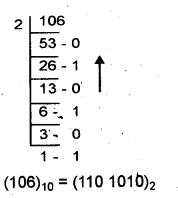
Question 5.
Convert (106)10 = ( )8
Answer:
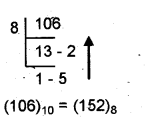
Question 6.
(106)10 = ( )16?
Answer:

Question 7.
Convert (55.625)10 = ( )2
Answer:
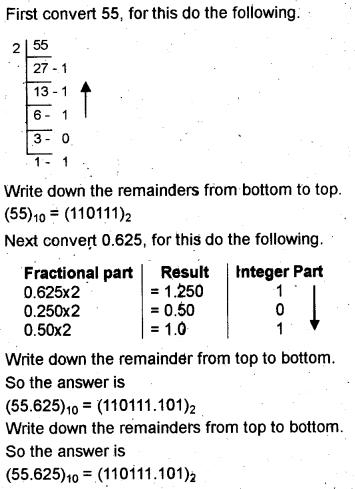
Question 8.
Convert (55.140625)10 = ( )8
Answer:
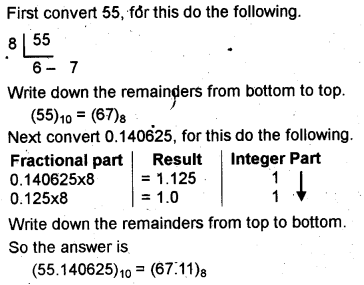
Question 9.
(55.515625)10 = ( )16
Answer:

Question 10.
Convert (101.101)2 = ( )10?
Answer:

Question 11.
Convert (71.24)8 = ( )10?
Answer:

Question 12.
Convert (AB.88)16 = ( )10
Answer:

Question 13.
Convert (1011)2 = ( )8?
Answer:
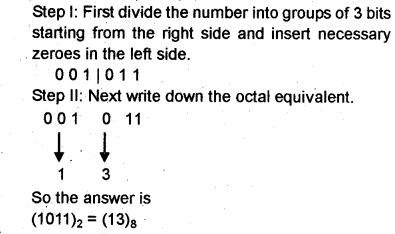
Question 14.
Convert (110100)2 = ( )16?
Answer:

Question 15.
(72)8 = ( )2?
Answer:
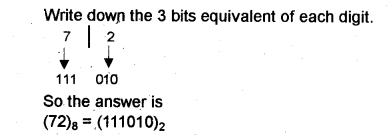
Question 16.
Convert (AO)16 = ( )2 ?
Answer:
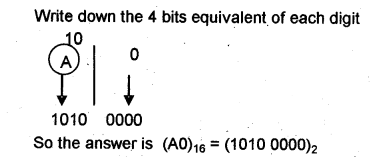
Question 17.
Convert (67)8 = ( )16 ?
Answer:
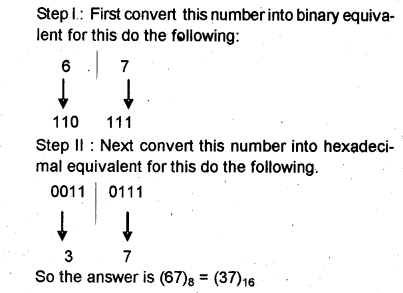
Question 18.
Convert (A1)16 = ( )8 ?
Answer:

Question 19.
Write short notes about Unicode Unicode
Answer:
it is like ASCII Code. By using ASCII, we can represent limited, number of characters. But using Unicode we can represent all of the characters used in the written languages of the world.
Eg:- Malayalam, Hindi, Sanskrit …….
Question 20.
What is the use of the ASCII Code ?
Answer:
ASCII means American Standard Code for Information Interchange. It is a 7 bit code. Each and every character on the, keyboard is represented in memory by using ASCII Code.
Eg:- A’s ASCII Code is 65 (1000001).
a’s ASCII Code is 97 (1100001)
Question 21.
Define the term’bit’?
Answer:
A bit stands for Binary digit. That means either 0 or 1.
Question 22.
Convert the decimal number 31 to binary
Answer:
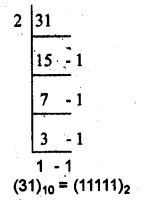
Question 23.
Find decimal equivalent of (10001 )2
Answer:
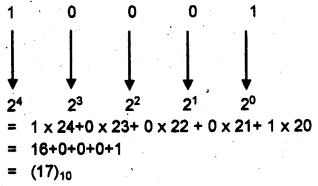
Question 24.
If (X)8 =(101011 )2 then find X.
Answer:
Divide the binary number into groups of 3 bits and write down the corresponding octal equivalent.

Question 25.
Fill the blanks
(____)2 = (AB)16
Write down the 4 bit equivalent of each digit
Answer:
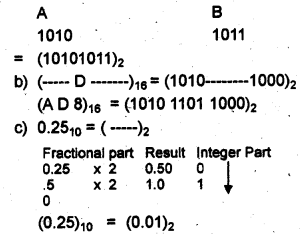
Question 26.
Represent-60 in 1’s complement form – 60 am 1’s complement form
Answer:
Change all 1 to 0 and all 0 to 1 to get the 1’s complement.
– 60 is in 1’s complement is 11000011
Question 27.
Define Unicode.
Answer:
The limitations to store more characters is solved by the introduction of Unicode.
It uses 16 bits so 216 =65536 characters(i.e,world’s all written language characters) can store by using this.
Question 28.
Find the smallest number in the list.
a) (1101)2
b) (A)16
c) (13)8
d) (15)10
Answer:
Convert all the numbers into a common base i.e. to decimal

Question 29.
Represent – 83 in 1’s complement form.
Answer:
Divide the number 82 by 2 successively and write down the remainders from bottom to top + 83=01010011
To take 1 ‘s complement of a binary number change all 1 s to 0 and all 0’s to 1.
Hence – 83 is 10101100
Question 30.
a) Write the two’s complement form of the decimal number-119.
b) State the benefit of using two’s complement representation as compared to one’s complement form.
Answer:
Binary equivalent of 119 in 8 bit is (0111 0111)2.
To find the 2’s complement of -119. First find the 1’s complement and Odd 1 to it.

b) If a computer uses 8 bit word length, 1 ’s complement method can represent numbers from – 127 to + 127. That means only 127 + 128 = 255 numbers can represent. But 2’s complement method can represent numbers from – 128 to + 127. That means we can represent a total of 256 numbers. We can represent one number more in 2’s complement representation.
Question 31.
Write a short note on Unicode.
Answer:
It is like ASCII Code. By using ASCII, we- can represent limited number of characters. But using Unicode we can represent all of the characters used in the written languages of the world.
Eg:- Malayalam, Hindi, Sanskrit,….
Question 32.
“Central Processing Unit (CPU) is the brain of the computer”. What is the role of Control Unit (CU) in the CPU?
Answer:
All the activities of a computer is controlled by the control unit. That means the function of key board, mouse, monitor, memory etc. are controlled by the control unit.
Question 33.
Storage of data, capturing of data, processing of data, input of data, and output of data are the different stages in data processing. Write these stages in correct order?
Answer:
1) Capturing of data
2) Input of data
3) Storage of data
4) Processing of data
5) Output of data
Question 34.
There is a memory inside the CPU. What is its name? Write down its purpose In the computer.
Answer:
It stores data, intermediate results, Address, instructions etc for CPU to process temperarily.
Question 35.
Convert the hexadecimal (A2D)16 into its octal equivalent.
Answer:
Step 1: First convert the number into binary for this do the following.
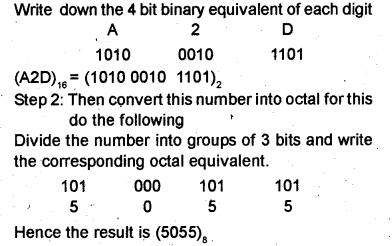
Plus One Computer Application Fundamentals of Computer 3 Marks Questions and Answers
Question 1.
Briefly explain data, information and processing with real life example.
Answer:
Consider the process of making coffee.
Here data is the ingredients – water, sugar,milk and coffee powder.
Information is the final product- i.e, Coffee Processing is the series of steps to convert the in-gradients into final product, Coffee. That is mix the water,sugar and milk and boil it. Finally pour the coffee powder.
Question 2.
Differentiate manual data processing and electronic data processing?
Answer:
In manual data processing human beings are the processors. Our eyes and ears are input devices. We get data either from a printed paper, that can be read using our eyes or heard with ears. Our brain is the processor and it can process the data, and reach in a conclusion known as result. Our mouth and hands are output devices.
In electronic data processing the data is processing with the help of a computer. In a super market, key board and hand held scanners are used to in. put data, the CPU process the data, monitor and printers (Bill) are output devices.
Question 3.
Complete the series.
(a) 3248,3278,3328 ,______,______.
(b) 5678,5768,6058 ,______,_______.
Answer:
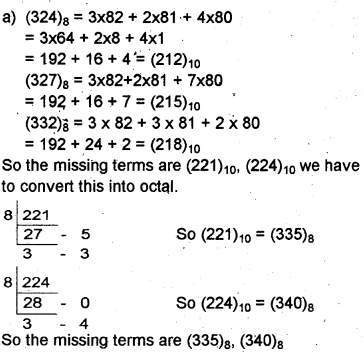
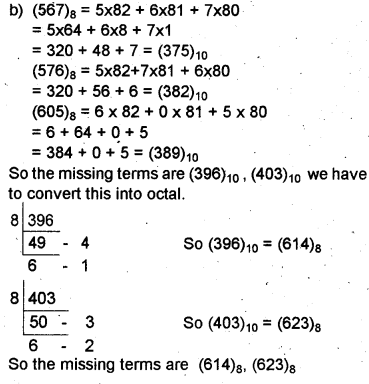
Question 4.
Fill up the missing digits
(a) (4___)8=(___110)2
(b) ( __7___ )8 = (100 ___ 110)2
Consider the following:

Answer:
a) 4 ……..100
and 110 ……… 6
So (46)8 = (100 110)2
b) 100 ……… 4
7 ………. 111
110 …….. 6
So (476)8 = (100 111 110)2
Question 5.
Fill up the missing numbers.
(a) (A ___)16 = ( ___ 1001)2
(b) ( __ B ___ )16 = (1000 ___ 1111)2
consider the following:

Answer:
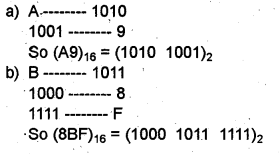
Question 6.
Complete the Series.
(a) 6ADD , 6ADF , 6AE1 ___,____.
(b) 14A9,14AF , 14B5 , ___,____.
Answer:
a) Consider the Seguence.-
6ADD, 6ADF, 6AE1,
Here the ’numbers’ are
0,1,2, 3, 4, 5,6, 7, 8, 9,A,,B, C, D, E, F, 10, 11, ………
The difference between 6ADD & 6ADF is 2
![]()
So Add 2 to 6AE1 we will ge 6AE3 Then add 2 to 6AE3 we will get 6AE5 Therefore the missing terms 6AE3, 6AE5
b) Consider the sequence.
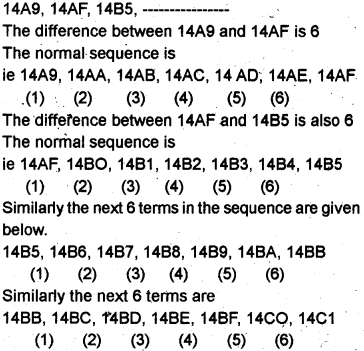
So the missing terms are 14BB and 14C1
Question 7.
Find the octal numbers corresponding to the following numbers using shorthand method.
Short hand method
(a) (ADD)16
(b)(DEAD)16
Answer:
a) Step 1 : Write down the 4 bit binary equivalent of each digit.
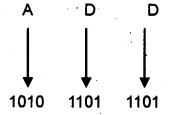
Step 2 : Divide this number into groups of 3 bits starting from the right and write down the octal equivalent.
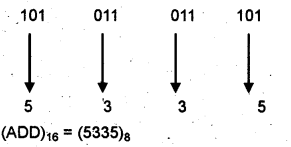
b) Step 1 : Write down the 4 bit binary equivalent of each digit.

Step 2 :Divide this number into groups of 3 bits starting from the right and write down the octal equivalent.

Question 8.
The numbers in column A have an equivalent number in another number system of column B.
Find the exact match.
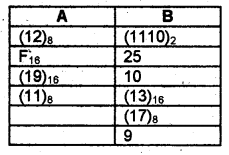
Answer:

Question 9.
ASCII Is used to represent characters in memory. Is it sufficient to represent all characters used in the written languages of the world ? Propose a solution. Justify.
Answer:
No It is not sufficient to represent all characters used in the written languages of the world because , it is a 7 bit code so it can represent 27 = 128 possible codes. To represent all the characters Unicode is used because it uses 4 bytes, so it can represent 232 possible codes.
Question 10.
If (126)x = (56)y , then find x and y.
Answer:
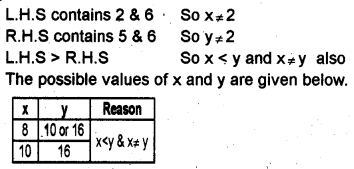
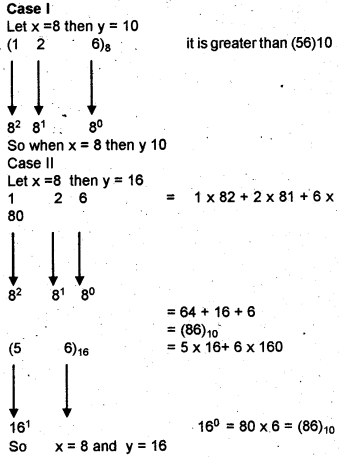
Question 11.
If (102)x = (42)y then (154)x = (___) y.
Answer:
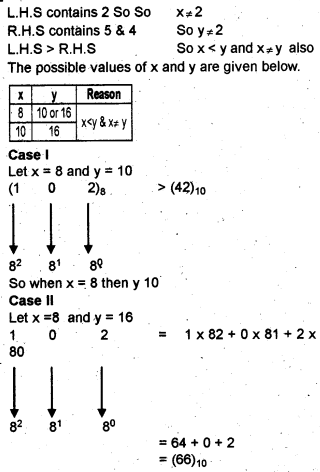
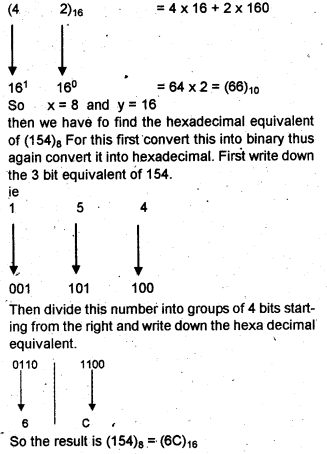
Question 12.
a) Name various number systems commonly used in computers.
b) Include each of the following numbers into all possible number systems
Answer:
a) The number system are binary, octal, decimal and hexa decimal.
b) 123 Octal, decimal and hexa decimal
569 Decimal, hexa decimal
1101 Binary, Octal, Decimal, Hexa decimal
Question 13.
Fill up the missing digit. (Score 1)
(41)8 = ( )16
Answer:
Step 1 : Divide the number into one each and write doWn the 3 bits equivalent.
Step 2: Then divide the number into group of 4 bits starting from the right then write its equivalent hexa decimal.’

So the answer is 21.
Question 14.
Fill up the missing digit. (Score 2)
If (220)a = (90)b then (451 )a = ( )10
Answer:
It contains 2 & 9, so a and b 2, b 8. The values of a can be 8 or 19. The values of b can be 10 or 16, L.H.S > R.H.S. a The possible values of a and b are given below
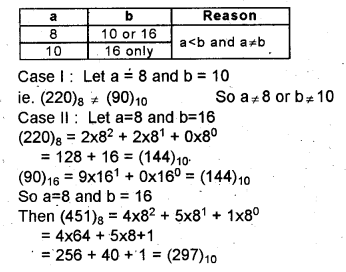
Question 15.
Fill up the missing digit. . (Score.3)
If (121)a = (441)b then (121)b = ()10
Answer:
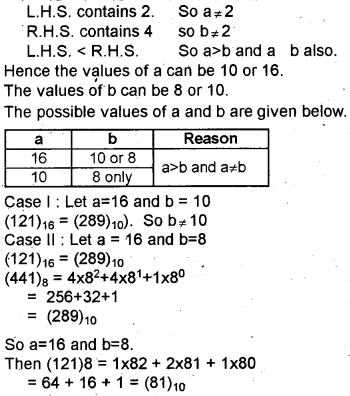
Question 16.
Fill up the missing digit. (Score 3)
If (128)a = (450)b then (16)a = ()10
Answer:
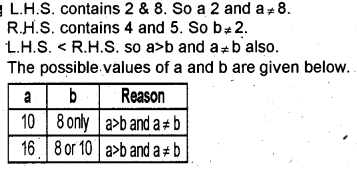
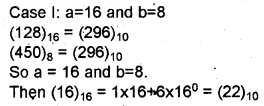
Question 17.
Fill up the missing digit.
(3A.6D)16 = ( )8
Answer:
Step I: Write down the 4 bits equivalent of each digit.
![]()
Step II : Divide this number into groups of 3 bit starting from the right side of the left side of the decimal point and starting from the left side of the right side of the decimal point.
So 00/111/010.011/011/010
Step III: Write the octal equivalent of each group: So we will get. (72.332)8
(3A.6D)16 = (72.332)8
Question 18.
What are the various ways to represent integers in computer?
Answer:
There are three ways to represent integers in computer. They are as follows:
1) Sign Magnitude Representation (SMR)
2) 1’s Complement Representation
3) 2’s Complement Representation .
1) SMR : Normally a number has: two parts sign and magnitude, eg:- Consider a number +5. Here + is the sign and 5 is the magnitude. In SMR the most significant Bit (MSB) is used to represent the sign. If MSB is 0 sign is +ve and MSB is 1 sign is – ve.

Here MSB is used for sign then the remaining 7 bits are used to represent magnitude. So we can represent 27 = 128 numbers. But there are negative and positive numbers. So 128 + 128 = 256 number. The numbers are 0 to + 127 and 0 to – 127. Here zero is repeated. So we can represent 256 – 1 = 255 numbers.
2) 1’s Complement Representation : To get the 1’s complement of a binary number, just replace every 0 with 1 and every 1 with 0. Negative numbers are represented using 1’s complement but + ve number has no 1’s complement,
eg:- To find the 1 ‘s complement of 21 +21 = 00010101
To get the 1 ‘s complement change all 0 to 1 and all 1 to 0.
– 21 = 11101010
1’s complement of 21 is 11101010
3) 2’s Complement Representation : To get the 2’s complement of a binary number, just add 1 to its 1’s complement +ve number has no 2’s complement.
eg:- To find the 2’s complement of 21
+21 = 00010101
First lake the 1’s complement for this change all 1 to 0 and all 0 to 1

2’s complement of 21 is 1110 1011
Question 19.
Match the following.
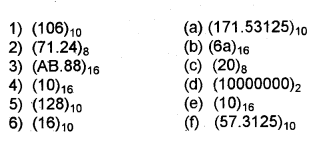
Answer:
1-b
2-f
3-a
4-c
5-d
6-e
Question 20.
Pick invalid numbers from the following.
i) (10101 )8
ii) (123)4
iii) (768)8
iv) (ABC)16
Answer:
i) (10101 )8 – Valid
ii) (123)4 – Valid
iii) (768)8 – Invalid. Octal number system does not contain the symbol 8
iv) (ABC)16 – Valid
Question 21.
Find the largest number in the list
i) (1001 )2
ii) (A)16
iii) (10)8
iv) (11)10
Answer:
Convert all numbers into decimal

Question 22.
If (11011)2 = (A)8 = (B)16 = (c)10.
Find the value of A, B and C.
Answer:
i) To find the value of A, First divide the binary number (11011)2 into groups of 3 bits (starting from the right) Then write down the corresponding octal number of each group for this insert a zero (0) in the left side of the binary number.

ii) To find the value of B, First divide the binary number (11011)2 into groups of 4 bits (starting from the right). Then write down the corresponding.
Hexa decimal equivalent of each group. For this insert 3 zeroes in the left side of the binary number.

iii) To find the value of C find the decimal equivalent so as to do the following.

Question 23.
(i), Binary representation of +38 is 00100110. Which of the following is the 2’s compliment representation of -38?
a) 11011001
b) 00100111
c) 11011010
d) 11011011
ii) If the Octal representation of decimal number X is (64)8. Find the hexa decimal equivalent of X.
Answer:
i) (c) 11011010
ii) Step 1 : First convert the octal number (64)8 into binary for this write down the 3 bit binary equivalent

Step II:- The obtained binary number is divided into groups of 4 bits, starting from the right. For this insert 2 zeroes in the left side. After that write down the corresponding Hexa decimal number .

Question 24.
Convert the decimal number 29 into binary. Using sign and magnitude form arid 1 ’s complement form represent +29 and -29 in memory in 8-bit word length?
Answer:
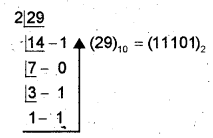
A computer with 8 bit word length, sign and magnitude representation of +29 is (00011101)2 and -29 is (10011101)2.
1 ’s complement form of (-29) is (11100010)2.
Note : To find the 1 ’s complement of (+29), change all ones to zeroes and all zeroes to ones.
Question 25.
Data processing refers to the activities performed on dafa to generate information. List the stages of data processing.
Answer:
Data processing phases (6)
a) Capturing data – In this step acquire or collect data from the user to input into the computer.
b) Input- It is the next step. In this step appropriate data is extracted and feed into the computer.
c) Storage – The data entered into the computer must be stored before starting the processing.
d) Processing /Manipulating data – It is a laborious work. It consists of various steps like computations, classification, comparison, summarization etc. that converts input into output.
e) Output of information – In this stage we will get the results as information after processing the data.
f) Distribution of information – in this phase the information(result) will be given to the concerned persons / computers.
Question 26.
a) Convert (1010.11)2 to decimal.
b) Find the missing terms in the following series.
Answer:
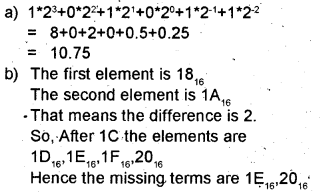
Plus One Computer Application Fundamentals of Computer 5 Marks Questions and Answers
Question 1.
Explain the components of Data processing
Answer:
Data processing consists of the techniques of sorting, relating, interpreting and computing items of data in order to convert meaningful information. The components of data processing are given below.
a) Capturing data – In this step acquire or collect data from the user to input into the computer.
b) Input – It is the next step. In this step appropriate data is extracted and feed into the computer.
c) Storage – The data entered into the computer must be stored before starting the processing.
d) Processing / Manipulating data – It is a laborious work. It consists of various steps like computations, classification, comparison, summarization, etc. that converts input into output.
e) Output of information – In this stage we will get the results as information after processing the data.
f) Distribution of information – In this phase the information(result) will be given to the concerned persons / computers.
Question 2.
Define computer. What are the characteristics?
Answer:
A computer is an electronic device used to perform operations at very high speed and accuracy. Following are the characteristics of the computer.
1) Speed : It can perform operations at a high speed.
2) Accuracy : It produces result at a high degree . of accuracy.
3) Diligence: Unlike human beings, a computer is
free from monotony, tiredness, lack of concentration etc. We know that it is an electronic machine. Hence it can work four hours without making any errors.
4) Versatility: it is capable of performing many tasks. It is useful in many fields.
5) Power of Remembering: A computer consists of huge amount of memory. So it can store and recall any amount of information. Unlike human beings it can store huge amount of data and can be retrieved when needed.
Disadvantages of computer
(1)No. IQ : It has no intelligent quotient. Hence they are slaves and human beings are the masters. It can’t take its own decisions.
(2) No feelings: Since they are machines they have no feelings and instincts. They can perform tasks based upon the instructions given by the humans (programmers)
